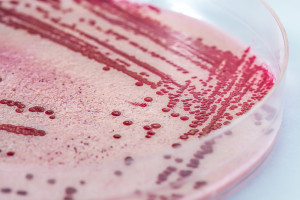
Listeria bacteria on a plate. The biology of HIV/AIDS suggests T-cells have a hitherto unrecognized way of killing pathogens like these.
The immune system, despite its immense complexity, really has only a few ways to kill bacteria:
- Neutrophils and macrophages can capture and digest extracellular bacteria (ones that live free in tissues and the bloodstream).
- Peptides (protein fragments) can punch holes in bacterial membranes or cross the membranes to disrupt bacterial processes.
- T-cells can kill cells infected by intracellular bacteria (ones that take up residence within cells).
It’s this last mechanism that I want you to pay attention to. The conventional wisdom has long held that T-cells can only kill intracellular bacteria indirectly by eliminating the cells they’ve infected. But a paper by Judy Lieberman, MD, PhD, of Boston Children’s Hospital’s Program in Cellular and Molecular Medicine, reveals that T-cells have a hitherto unnoticed way of directly killing intracellular bacteria And she only found it because of HIV/AIDS.
It’s long been recognized that patients with HIV/AIDS—which knocks down the T-cell counts—are highly susceptible to bacterial infections. However, T-cells have always been thought to play only a minor role in defending against bacteria. “It’s one of the paradigms of immunology,” Lieberman explains. “T-cells protect against viruses, and other cells handle bacteria.”
Antimicrobial hole punch
The biology of HIV/AIDS, Lieberman contends, suggests that T-cells must therefore have an unknown method of killing bacteria directly. To tease that method out, Lieberman and Michael Walch, PhD, (now an assistant professor at the University of Fribourg) started with what’s currently known about T-cells’ response to intracellular bacteria. When faced with an infected cell, T-cells release cell-killing granules containing three kinds of proteins:
- perforins (which punch holes in cell membranes)
- granulysins (which open pores in the membranes of bacterial, fungal and parasite cells)
- granzymes (enzymes that trigger the death of mammalian cells)
The granzymes get inside the cell and cut up proteins in mitochondria (our cells’ power plants), interrupting cell metabolism. This causes mitochondria to produce toxic compounds called reactive oxygen species (ROS), which trigger the infected cell to kill itself through the process of apoptosis, or programmed cell death.
Working with specially engineered mice, Lieberman and Walsh found that there’s more to the story. As they reported in Cell, the pair discovered that granzymes directly attack and kill intracellular bacteria like Listeria monocytogenes through a series of similar but faster steps.
First, perforin opens a path into the Listeria-infected cell. Then granulysin punches a hole into the membrane of the bacterial cell, enabling granzymes to get into the bacteria. Once inside, the granzymes do just what they do to cells’ mitochondria: They interrupt metabolism, triggering ROS production and bacterial death.
Bacterial death starts within minutes and can take only a half hour. By comparison, it can take two hours for T-cells to kill an infected cell.
But when you think about it, that’s the order in which you’d want things to happen. Otherwise, if an infected cell dies and the bacteria within it survive, they could be released and spread to other cells.
You can’t find what isn’t there
So why hasn’t this phenomenon of direct bacterial killing by T-cells been noticed before? Lieberman cites the immunology field’s reliance on the mouse as an experimental model.
“Our immune system has evolved to fight our infections, not the ones that mice get,” she explains. “And mice don’t have granulysins.” Which means that mouse granzymes normally have no way of getting into intracellular bacteria. So any experiments using mice with regular mouse immune systems would never reveal the enzymes’ direct effects. Lieberman and Walsh had to rely on mice specially engineered to produce granulysin in order to tease out its effects.
Lieberman suspects there may be even more to the story. “We’ve only looked at one species of intracellular bacteria and haven’t really explored extracellular species. There may be other T-cell antimicrobial peptides involved as well.”
She also thinks this mechanism could prove important for better understanding the immune system’s response to tuberculosis, a globally important intracellular bacterium that in many countries is closely associated with HIV/AIDS. It might also help provide new insights into how the body controls gut pathogens, and highlight new targets for antibiotic development.
“This may be the beginning of a whole new field of study in immunology,” she says.
Join us at the Global Pediatric Innovation Summit + Awards 2014 on October 30-31 in Boston. Seats are limited, so register today at www.takingontomorrow.org. Please use the code VECTOR at check-out for a 10% discount.








